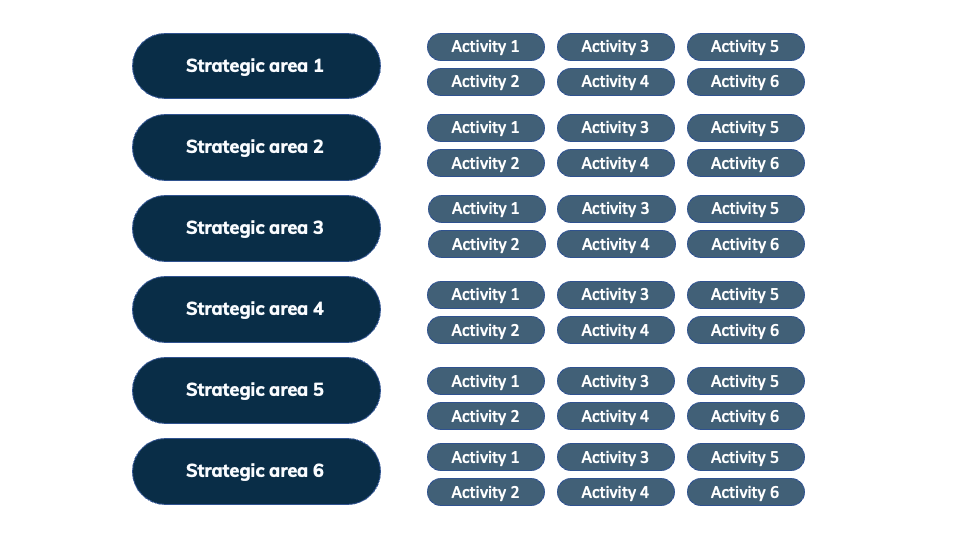Welcome back to our blog series on “Strategy Acceleration,” inspired by the book written by Ulf Arnetz and Catrin Brodin. This series is designed for those who want to master the art of executing company strategy. If that sounds like you, keep reading!
We’re well aware that many companies struggle with strategy execution, often due to a traditional approach. To avoid falling into the same trap, we’re here to explore the differences between traditional strategy execution and strategy acceleration. In our previous post, we discussed the significance of time. Today, we’ll delve into the topic of goal setting, emphasizing the importance of focus and avoiding the “everything at once” mentality.
To illustrate the disparities between traditional strategy execution and strategy acceleration, we have chosen to compare them across various factors contributing to the success or failure of strategy implementation. We aim to shed light on what needs to be done differently, challenging existing beliefs about what is achievable. In the following examples, we’ll outline how things are typically done in traditional strategy execution, as well as how strategy acceleration operates.
If you find similarities between your organization’s approach and traditional strategy execution, don’t be disheartened. In fact, recognizing the differences between these two approaches is a positive step. It allows you to consider alternative ways of working, potentially revolutionizing your perspective on strategy.
Albert Einstein once said, “Insanity is doing the same thing over and over again and expecting different results.” With that in mind, let’s examine the shortcomings of traditional strategy execution.

Traditional strategy execution often involves defining numerous strategic areas to focus on, typically ranging from 10 to 15 areas. Each area encompasses multiple associated activities intended to move the entire company toward its goals incrementally. However, in practice, this rarely occurs. The problem lies not in the choice of activities or areas but rather in the overwhelming number of them. Consequently, little progress is made on any front. Additionally, a significant challenge in traditional strategy execution is the management’s inability to prioritize the most crucial activities or areas.
One prevalent issue in traditional strategy execution is the presence of numerous and ill-defined goals. Examples of such goals include “increasing profitability,” “enhancing revenue,” “improving efficiency,” and “becoming more environmentally sustainable.” While these goals may be defined, they often lack clarity and measurability. This uncertainty hinders effective prioritization and focus on the right activities, leading to a perpetual feeling of not knowing when the job is done.
Strategy acceleration, in contrast, demands strong focus and prioritization skills from management. Selecting strategic goals that will have the greatest impact becomes a pivotal task. Although every manager and employee may passionately argue for their own area’s importance, it is crucial to establish a structured prioritization process. This process should consistently prioritize activities that deliver the most value. By identifying the strategic initiative that adds the most monetary value, the organization can avoid endless discussions and conflicts surrounding what is truly crucial. Failure to establish a structured prioritization process results in wasted calendar time and ongoing debates about priorities.
It is essential to clarify that the prioritization we discuss here focuses on the strategic aspects that drive long-term sustainability for the company. For instance, a quick 10% reduction in costs achieved through substantial layoffs may not maximize the company’s value and competitive power in the long run. This distinction is worth reflecting upon.

In strategy acceleration, goals are set based on their ability to generate the most monetary value and their measurability over time. For example, goals may include increasing profitability from 10% to 20% in two years, doubling revenue from $100M to $200M in one
year, or reducing carbon dioxide emissions from 4% to 2% in three years. This approach ensures that goals are measurable and provides a clear understanding of progress. It allows everyone to grasp how their actions contribute to the overall objectives. The goals set in strategy acceleration are known as Most Important Goals (MIGs).

You may be wondering whether everything can be measured in monetary terms, especially in departments that don’t directly generate income or in sectors like environmental issues or charities. In upcoming blog posts, we will address this concern and demonstrate how to measure and set goals even in those contexts.
To accelerate your strategy and achieve success, prioritizing what matters the most—your Most Important Goals—is crucial. Strategy acceleration recommends focusing on no more than two MIGs at a time. By setting clear, measurable goals aligned with the organization’s strategic priorities, you can drive focused action and ensure progress towards desired outcomes.
Stay tuned for our next blog post, where we’ll further explore the disparities between traditional strategy execution and strategy acceleration. We’ll shed light on the organizational and behavioral aspects of strategy execution, providing additional insights and strategies for successful implementation.
What are you waiting for?
Howwe is the Solution for Growth.
With our method and software, we simplify the execution of your strategy.




